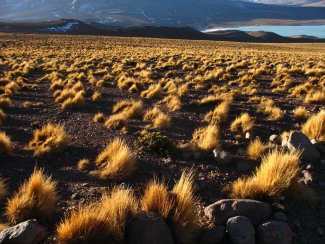Native to Mexico, Central America: Costa Rica; El Salvador; Guatemala. Northern South America: Venezuela. Southern South America: Argentina - Cordoba, - Mendoza, - Buenos Aires, - Catamarca, - Entre Rios, - Jujuy, - La Pampa, - La Rioja, - Rio Negro, - Salta, - San Juan, - San Luis, - Santa Fe, - Santiago del Estero, - Tucuman
Western South America: Bolivia; Colombia; Ecuador; Peru.
This fine textured bunch grass grows 2 to 3 feet tall, 1 foot wide and moves with the slightest breeze. Full sun or light shade, quite heat resistant, prefers rocky soils but can handle clay. Good in large containers or with Rock Roses and Lavenders. It's similar to Mexican Feather Grass but doesn't reseed as much in low water situations. Lime green can fade to beige in winter. Showy feather-like flowers appear in spring with showy silken awns, very featherlike. Flowers mature to a golden color and explode by mid-summer. Full sun or light shade, quite heat resistant and is an extremely durable hot weather plant.
HABIT Perennial; caespitose; clumped densely. Culms (50–)80–100 cm long. Culm-internodes smooth to scaberulous. Leaves basal and cauline; differentiated into sheath and blade. Leaf-sheaths wider than blade at the collar; smooth, or scaberulous; glabrous on surface. Leaf-sheath oral hairs bearded. Ligule an eciliate membrane; 0.7 mm long; hyaline; lacerate; truncate. Leaf-blades erect to ascending; filiform; conduplicate; 15–45 cm long; 0.5–0.9 mm wide; stiff. Leaf-blade surface scaberulous.
INFLORESCENCE Bisexual. Inflorescence a panicle.
Panicle contracted; lanceolate to elliptic; 18–40 cm long. Primary panicle branches bearing spikelets almost to the base.
Spikelets solitary. Fertile spikelets pedicelled. Pedicels puberulous.
FERTILE SPIKELETS Spikelets comprising 1 fertile florets; without rhachilla extension. Spikelets oblanceolate; subterete; 7–9 mm long; breaking up at maturity; disarticulating below each fertile floret. Floret callus brief; straight to curved; 0.1 mm long; bearded; acute.
GLUMES Glumes similar; exceeding apex of florets; thinner than fertile lemma; shiny. Lower glume lanceolate; 9–11 mm long; 1–1.1 length of upper glume; hyaline; pallid, or purple; without keels; 3 -veined. Lower glume margins flat. Lower glume apex setaceously attenuate. Upper glume lanceolate; 9–11 mm long; 3 length of adjacent fertile lemma; hyaline; pallid, or purple; without keels; 3 -veined. Upper glume apex setaceously attenuate.
FLORETS Fertile lemma linear to lanceolate; subterete; 2.5–3 mm long; membranous; dark brown; without keel; 5 -veined. Lemma surface pilose. Lemma margins flat; covering most of palea. Lemma apex surmounted by a ring of hairs; with this appendage 3–4 mm long; awned; 1 -awned. Principal lemma awn bigeniculate; 11–13 mm long overall; with 5–8 mm long limb; with twisted column; deciduous; abscissing from top of lemma; limb scabrous. Palea lanceolate, or oblong; tightly convolute around flower; 0.5 length of lemma; 2 -veined; without keels. Palea apex entire; obtuse.
FLOWER Lodicules 3; oblong; 0.5 mm long; membranous; obtuse. Anthers 3; 0.6–0.7 mm long; anther tip penicillate. Stigmas 2.
FRUIT Caryopsis with adherent pericarp; fusiform. Hilum linear.
Goes well with other drought tolerant Mediterranean plants, succulents, other stipas – good in masses or as accent plant. Can handle clay soil and is good for coastal conditions. It is sold as an attractive ornamental. The species could become a problem, because it is self-compatible and produces a large quantity of wind-dispersed seeds. In parts of its native range, it is highly valued for its ability to prevent soil erosion, and for its use in thatch, mats, and basketry.
